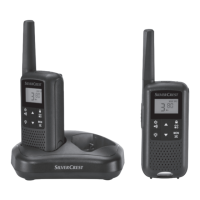19 GB/IE/NI
You can also charge the handheld transceivers directly without using the
charging cradle. Open the rubber cover of the USB charging socket
9
before you insert the Micro-USB plug to the USB charging socket
9
.
Plug USB Type A plug into a USB power supply, and then plug the USB
power supply into a nearby wall socket.
The Battery level indicator
23
in the upper right corner of the display
scrolls while charging
Connecting the headset
On the top of handheld transceiver there is a 2.5mm connection for a
headset
3
.
Open the rubber cover and then plug you headphones (not included) into
this socket.
P Getting started
NOTE: The handheld transceivers work as a pair and need to
communicate with each other using the same communication channel and
also the same CTCSS (Continuous Tone-Coded Squelch System), or DCS
code (Digital Code Squelch ). Also, they will need to be within a 10 km
range in an open field to work, as buildings, forests and areas of high
ground can reduce the range. On a free channel, others who have a PMR
or receiver can follow your conversation.
Power ON the handheld transceiver
To power ON the handheld transceiver press and hold the button
13
for at least 3 seconds. Then an acoustic signal can be heard and the
current set channel will be shown in the display
1
. At this moment, the
handheld transceiver will be in receiver mode.
Power OFF the handheld transceiver
To power OFF the handheld transceiver press and hold the button
13
for
at least 3 seconds. Then an acoustic signal can be heard and the display
1
will turn off.
3

